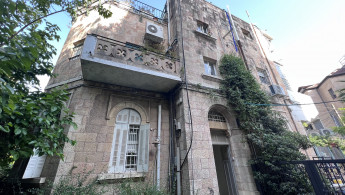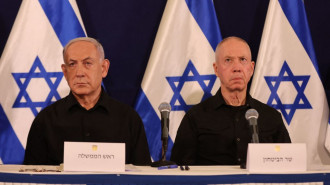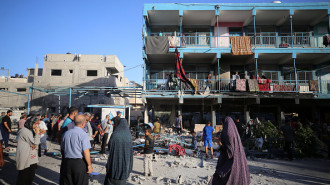Nakba at 75: Great granddaughter tells family story of dispossession in Jerusalem's Qatamon
Every year in May, Palestinians mark the Nakba. The term refers to the forceful displacement of hundreds of thousands of Palestinians from their homes and lands between 1947 and 1949, foremost at the hands of Zionist militias and then by the State of Israel.
When Othman Abdelatif, a successful coffee and spice merchant from the Old City of Jerusalem, decided to build a home for himself and his family, he set his eyes on a new affluent neighbourhood southwest of the Old City called Qatamon.
Qatamon, then, was one of several predominantly Arab neighbourhoods that sprouted outside the Old City of Jerusalem. According to research, twelve Arab neighbourhoods were built in West Jerusalem in interwar Palestine. These new communities often included spacious homes constructed of fine stone and often had a garden.
In contrast, Jewish areas were built hastily to house an increasing number of immigrants who came to settle the land and create a Jewish national home in Palestine, as stipulated in the Balfour Declaration of 1917.
In the years that followed the First World War, Palestine experienced fairly high economic growth as stability prevailed. In addition, the Old City was becoming overcrowded and new markets were opening up. So, in 1944, Othman purchased a plot of land in Qatamon and commenced building his "dream house" in 1946, his great-granddaughter Najla said.
On 29 November 1947, the UN General Assembly adopted the resolution to partition Palestine into two states: Jewish and Arab. The British rule over Palestine was coming to an end. These were momentous events.
Othman must have seen the conflict looming on the horizon but was already too invested in his project. So he presses on and moves to his new three-story home in Qatamon with his wife, three sons, and two daughters. He probably never imagined that he would be forced to flee his new residence only several months later.
The security situation quickly deteriorated in Qatamon as elsewhere in Palestine after the partition vote.
On the night of 5 January 1948, while British forces were still in Palestine, the principal Jewish militia, the Haganah, attacked and blew up the Semiramis Hotel in Qatamon, owned by two Palestinian Christian families. Eighteen people were killed and dozens wounded; most of the dead belonged to the families of the hotel's owners. The detonation illuminated the sky above the neighbourhood for several minutes and shook the walls of houses hundreds of meters away.
Then two more explosions rocked Qatamon on the night of 13 March as fighting broke out between Palestinians and Jewish immigrants. Residents now began packing their belongings to move to safer areas.
As the fighting intensified, the Palestinian population in Qatamon began to dwindle. And when on the evening of 13 April, Jewish militias targeted the neighbourhood with mortar shells, more residents left.
The decisive assault came two weeks later, on April 29. The Haganah and Palmach forces organised a joint attack to take over the prestigious Palestinian neighbourhood.
Palestinian writer Hala Sakakini stayed with her father, the famous Arab nationalist and intellectual Khalil Sakikini, until the last hours before the fall of Qatamon. She wrote in her memoirs:
"The firing was heavy and continuous and it sounded so very near all of us thought that the Jews had reached our street. Every one of us deep down in his heart feared that before morning we would all be dead. When at last morning came the firing had not ceased. It went on and on, loud and strong. The Jews had come in very large numbers and they were trying to surround Katamon and besiege it. Already fifteen of our fighters had been killed and thirty wounded."
With Palestinian fighters routed, the Qatamon fell. Homes were looted, and properties, including personal libraries, were seized.
Qatamon had two hundred and twenty-four homes in it, according to research by Dr Adnan Abdel Razek, published in his book, 'Records of the Palestinian immovable property in West Jerusalem.'
'A beautiful house in a beautiful neighbourhood'
The homes in Qatamon were "re-populated by Jews," many of whom were "ironically themselves war refugees from the Old City," Israeli academic Itamar Radai wrote.
Israeli flags can now be seen hanging from house windows and balconies as if the Haganah and Palmach had just taken over the neighbourhood.
Fearing for his family's lives, Othman Abdelatif left Qatamon for a safer place as the situation worsened.
"Little did they know it would be their last time there. They went to seek refuge in East Jerusalem, then to Amman, later to Jericho, and eventually back to East Jerusalem, where they remain to this day," his great grand-daughter Najla wrote.
As we walked the street where Othman built a home and briefly lived with his wife and five children, Najla said, "I can't help imagining growing up in that house, but now it's entirely Israeli taken stollen basically."
Najla spends her time between Jerusalem and Stockholm working in environmental advocacy. She firmly believes her work promoting an eco-friendly lifestyle in Palestine and the Middle East is "not a Western concept."
"We are really connecting with our ancestors and living the traditional Palestinian way and going back to our roots as the environmentalist Palestinians that we really are," she asserted.
Currently, Najla lectures Palestinians of different ages and backgrounds about the concept of zero waste.
By 16 November 1948, the entirety of West Jerusalem was occupied by Zionist forces, and some 60,000 Palestinians had been expelled.
With the signing of the armistice agreement between Israel and Jordan on 3 April 1949, the division of Jerusalem, East and West, became official.
This is despite the designation of Jerusalem as "corpus separatum" or separate body by the UN General Assembly's partition vote of November 1947.
In the Middle East war of June 1967, Israel completed the occupation of Palestine when it seized the West Bank from Jordan and the Gaza Strip from Egypt.
The Palestinian-Israeli conflict rages to this day with no end in sight.







 Follow the Middle East's top stories in English at The New Arab on Google News
Follow the Middle East's top stories in English at The New Arab on Google News


